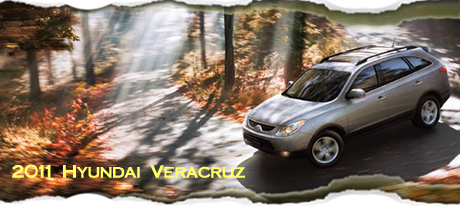
2011 Hyundai Veracruz CUV Road Test Review
By Bob Plunkett
On the palm-fringed Coral Way Boulevard in Coral Gables, ritzy Miami suburb, we're feeling the luxurious ride quality and get-up-and-go attitude of a Veracruz, the seven-seat crossover utility vehicle (CUV) from Hyundai of South Korea.
Stretching long and decorated with a raked face flashing tri-tiered headlamp clusters on front corners plus curvaceous fenders over multi-spoke alloy wheels, the Veracruz presents a hunkered athletic posture with elegant sheetmetal curves.
The lower body wrapped in a band of black trim seems substantial and strong like a conventional wagon but the upper section including a narrow wrap of windows with the radically-raked windshield and a roofline tapering down to the tail may be more reminiscent of some classic sports car or even a racy GT-style coupe.
It's taut and athletic in a sculptural shape, but also smooth and sleek, even sensuous -- and clearly a departure from the two-box school of SUV styling.
Hyundai's big idea for Veracruz seems to make it different from the typical SUV or CUV.
It's large -- as long as a big sedan and equally wide, with a prominent hood and broad grille consuming the face between the clusters of headlamps.
It has lots of doors.
There's a pair of portals on each flank below what looks like one extremely long and narrow window stretching from the windshield clear back to the tail.
Also, a top-hinged liftgate at the rear swings high for access into the cargo bay.
Inside a spacious cabin are three rows of seats with capacity for as many as seven passengers.
The front row contains a pair of bucket seats flanking a center console, the second row has a three-place bench split 60/40 with a fold-flat seatback on the left and a flip-and-fold section on the right, and the third row shows a two-seat bench split 50/50 that folds down and disappears to form a flat floor in the cargo bay.
Hyundai packs aboard each edition of Veracruz a load of gear for safety.
For passive safety there are frontal and seat-mounted side-impact air bags for front-seat passengers, front seatbelt pretensioners and force limiters, front-seat adjustable active head restraints, second-row LATCH lower anchors and upper tether anchors, and curtain-style air bags posted above outboard seats for all three rows.
For active safety, each trim version gets a disc brake at every wheel, with electronic linkage to a four-channel anti-lock brake system (ABS) with electronic brake force distribution (EBD), plus an electronic stability control (ESC) device which automatically coordinates the brakes and throttle to check against lateral wheel skidding.
For dynamic vehicle handling as well as a comfortable ride quality, Veracruz employs a four-wheel independent suspension system with MacPherson struts up front and a multi-link arrangement in back.
The rack and pinion steering mechanism brings a direct touch with power boost keyed to engine-speed sensors.
All of the magic for this vehicle starts with its car-like unit-body structure which fosters a long (110-inch) wheelbase and a wide track of 65.7 inches up front as well as in back.
Pushing wheels to edges of the chassis brings stability to the stance and enhances Veracruz's agility when steered along a twisty route.
Another point: Hyundai guarantees excellent pedal juice out of Veracruz because every edition totes a strong engine promoting top-of-class performance.
The dual-overhead-cam (DOHC) Lambda transverse-mounted V6 displaces 3.8 liters and employs continuously variable valve timing (CVVT).
And it romps -- pumping 260 hp at 6000 rpm and 257 lb-ft of torque at 4500 rpm.
The engine links to a sophisticated electronically controlled six-speed automatic transmission by Aisin that adds a Shiftronic manual shift mode. To access the Shiftronic mode, a driver simply slaps the shifter lever laterally into a separate gate, and then tips the lever forward or back to bump sequentially up or down the gear ladder.
Standard configuration for Veracruz is the front-mounted engine with front-wheel-drive (FWD) traction.
However, for the Snow Belt Hyundai adds optional all-wheel-drive (AWD) with an electronic system which can transfer some of the engine's torque to drive the rear wheels if on-board wheel speed sensors detect that the front wheels are slipping.
The device also has a push-button lock mode for 50:50 torque split front/rear to maintain forward momentum at a low speed on slippery stuff.
There are two trim steps on Veracruz with the entry-level GLS and top-tier Limited.
Equipment standard on Veracruz GLS ranges from 17-inch aluminum alloy wheels capped with P245/65R17 tires to cabin air conditioning with separate second-row controls and power buttons for windows and door locks and exterior mirrors, eight-way power controls for the driver's seat with power adjustable lumbar support, a remote keyless entry device, tilting steering wheel with audio tabs and cruise control, trip computer, three 12-volt power outlets, electronic rear window defroster with timer, woodgrain interior trim and a 172-watt audio kit with six speakers and AM/FM/CD/MP3.
Veracruz Limited rolls on 18-inch aluminum alloy wheels ringed by P245/65R18 rubber, and the standard content includes a tilt-and-slide power sunroof, power tailgate, dual automatic climate control system, front door scuff plates, auto-dimming interior rearview mirror with compass, a leather-wrapped steering wheel and shift knob, leather upholstery, heated front seats, memory settings for power controls on the driver's seat, four-way power controls for the front passenger's seat, plus standard Infinity 314-watt audio package with eight speakers and AM/FM/XM/6-CD/MP3.
For 2011, the optional GLS premium package installs a power tilt-and-slide sunroof, power tailgate, auto dimming cabin mirror with HomeLink and compass plus auto-dimming tilt-in-reverse exterior mirrors.
Hyundai's MSRP chart for Veracruz begins at $28,145 for the GLS FWD, with Limited FWD tagged at $34,195. Adding the AWD equipment increases the bottom line by $1900 in GLS and $1,700 for Limited.
For more info on the Hyundai Veracruz, click here.
FOR MORE ROAD TEST REVIEWS - VISIT RTM'S NEW CAR REVIEW ARCHIVE
|